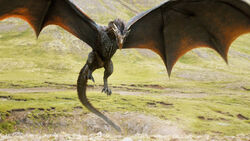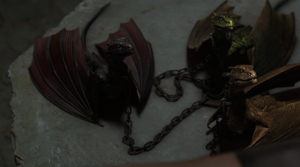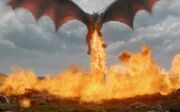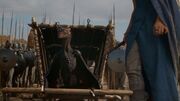for those questioning Drogon da gawd
Dragons
Dragons

Type
Reptile, magical
Diet
Obligate carnivore
Status
Extinct from circa 150-300 AL,
now reborn
Habitat
Preferably volcanic mountains
Range
Slaver's Bay (currently)
Valyrian Freehold,
Essos (formerly)
worldwide (formerly)
Origin
Fourteen Fires,
Valyrian Peninsula,
Essos
Dragons are massive, flying reptiles which can breathe fire onto their enemies, rumored to have a strong connection to
magic, later "proven" true when magic begins to return to the world after the birth of the first three in over two hundred years. Dragons possess awesome and terrible power, capable of laying waste to armies and burning entire cities to ashes. Men who were able to tame and ride dragons as beasts of war used them to burn their enemies and forge vast empires across the continents of
Essos and
Westeros.
The last surviving dragons in the world were possessed by
House Targaryen, who used them to conquer and unify the Seven Kingdoms of Westeros three hundred years before the
War of the Five Kings. The Targaryen dragons eventually died out about a century and a half later, however, after which the species was considered to be extinct throughout the world.
At the same time that the War of the Five Kings began in Westeros,
Daenerys Targaryen - last scion of the deposed House Targaryen - miraculously hatched three new dragons from their eggs, and for the first time in generations, filling the skies of the world with the music of dragons once again.
Biology
Overview

Dragons have different color patterns.
Dragons have long serpentine bodies, with proportionately long necks and tails. Their bodies have four limbs: two short back legs and two large wings as forelimbs, a similar body-plan to a bat. In later generations, after the dragons went extinct, physical descriptions of dragons became so confused in memory that artwork sometimes depicted them as having
six limbs - two wings growing out of their backs in addition to four legs - but this is inaccurate. The teeth and claws of adult dragons are as long and sharp as swords.

Daenerys marches forward with her army and her young dragons.
As reptiles, Dragons are covered in scales, as well as spiny horns which run down their backs from head to tail. Particularly large ridges of horns frame the edges of their faces, running along the back of the skull and along the jawline, which grow bigger as they mature. Adult dragons possess two sets of frills which run along the backs of their necks and spine, two along the sides of their necks and another two centered closer to the backbone, for a total of four frills. These are formed from webbing that grows between longer horny spines. When dragons are agitated (or simply excited), they raise and flare these frills - similar to how a furry animal like a cat will raise the
hackles on its back when agitated (or a feathered animal such as a goose will puff up its feathers), in an attempt to appear bigger so as to intimidate its enemies.

Dragons will roast their food before consumption.
Dragons are obligate carnivores, with diets consisting entirely of meat. Dragons need to roast their prey with their fire-breath before consuming it. Dragons can eat almost any kind of meat, anything from sheep to fish. Historical dragons ridden as beasts of war were known to eat fallen horses and even men on the battlefield. Fully grown dragons could swallow a live horse whole.
The scale color of dragons is highly variable, and historical dragons ranged in color from black to silver, red, gold, and even blue. Some dragons were one solid color throughout, but more often, they tend to have one primary color for most of their body, with highlights in a secondary color along their spinal crests, horns, and wing membranes. Markings observed so far include:
- Black with red markings
- Green with bronze markings
- Cream with gold markings
Fire-breath

Dragon fire melts just about everything.

Small tubes in Drogon's mouth showing where they spit fire from.
Probably the most famous attribute of dragons is their ability to breathe fire. Dragonflame can turn flesh to ash, melt steel, and crack stone. Older dragons can produce more intense flame for longer durations. Dragons seem to produce their fire-breath by expelling chemicals out of two tubes in the back of their throats: when these volatile substances combine, they undergo an intense reaction which bursts into a directed jet of fire. The bodies of dragons are also very resistant to fire, particularly their own flames, which don't even damage their own mouths as they expel them. Some believe that in many ways dragons
are fire, fire given form as flesh: it is said that "fire cannot kill a dragon".
Reproduction and Maturation
Like most reptiles, dragons lay clutches of eggs. Dragon eggs are roughly the size of a human child's head, and as heavy as stone, so they need to be carried with two hands. The outer shell is covered in scales, with vastly different color patterns between eggs, usually matching the color of the dragon inside. Dragon eggs are notoriously difficult to hatch, though they can maintain the spark of life inside of them for decades if not centuries. The secret key to hatching the eggs seems to involve some form of
blood magic: as the
House words of the Targaryens hint, it requires "fire and blood". To hatch them, dragon eggs must be burned in roaring flames, with which another creature is simultaneously being burned alive - a life in exchange for a life. In the wild this might just be a prey animal that the parent dragon kills, but human sacrifice will do the trick quite nicely, particularly if there is more than one egg to hatch.
The exact details of dragon reproduction fell out of living memory in the nearly two centuries since they died out. Several conflicting theories and rumors have been circulated, some less grounded in fact than others. It is unclear if the mother guarded eggs she had laid, or simply left them to hatch and fend for themselves, or if the father aided the mother in caring for them. Dragons were apparently relatively solitary creatures, though it is unknown if any hierarchical relationships formed within groups of dragons.
Dragons, like birds, tend to imprint on whoever is present when they hatch, regarding that person as their parent.

Drogon, already the size of a small dog.
Newly hatched dragons are about the size of a small cat, but they grow very rapidly, reaching the size of a small dog in about one year, and the size of a small pony in only three or four years. It is unknown at what age dragons reach reproductive maturity. Dragons never stop growing as long as they live, and they can live for centuries, though many died in combat before reaching such an age. The largest Targaryen dragon,
Balerion the Black Dread, lived for nearly two centuries and had a skull the size of a carriage.
When dragons hatch, they do have horns around their faces and along their spines, but they are still quite small and relatively rounded. Their horns grow increasingly longer and sharper as they mature, quickly making the dragon appear more dangerous and menacing to prey or other dragons. The four lines of webbed frills along a dragon's spine only grow to a prominent size after they are about a year old.
Game of Thrones: Season 4Season 1
Training and riding
Dragons cannot be truly tamed but they can be trained or mastered. The Valyrians rode dragons for millennia.
Aegon I Targaryen and his sister-wives, descended from Old Valyria, used the last three dragons in the world to conquer and unify the Seven Kingdoms.
Dragons are fairly intelligent animals, and like a horse or a dog, they can be trained by their rider to respond to basic voice commands.
History
Background
Five thousand years ago, men of the
Valyrian Freehold learned how to master and ride dragons as beasts of war, and used them to forge an empire that stretched across most of the continent of
Essos, dominating almost half of
the Known World. Four hundred years before the
War of the Five Kings, the entire Valyrian empire and almost all of its dragons were destroyed in a single day, during a cataclysmic volcanic eruption known as the
Doom of Valyria. One Valyrian noble family, the
Targaryens, survived the Doom on the distant island outpost of
Dragonstone in the
Narrow Sea - along with the last surviving Valyrian dragons.
One hundred years later,
Aegon I Targaryen and his sisters used the last three surviving dragons in the world to conquer and unify the Seven Kingdoms of Westeros. For generations, the dragon-kings ruled over much of Westeros - but the dragons eventually died out after nearly a century and a half, and the species was subsequently considered to be extinct.




taking those blades in its neck and saying the harpies were gonna overpower it is like saying mayweather got punched a few times so he's bound to lose. they're beasts of war, they take some hits, aint no thang














 If they dont address it next episode I think she's good. But they did make it obvious when he touched her.
If they dont address it next episode I think she's good. But they did make it obvious when he touched her.